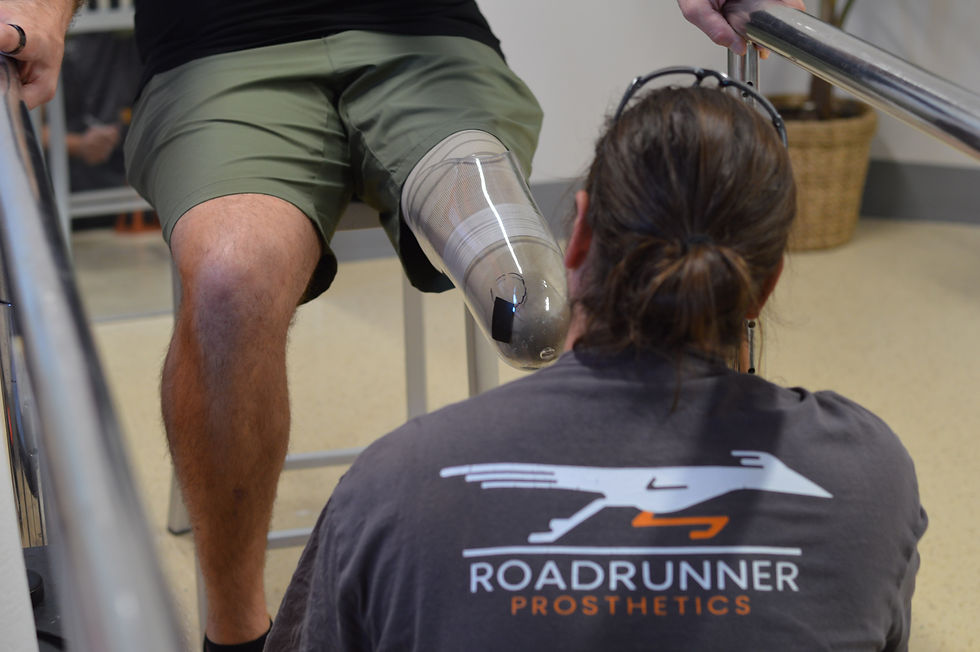New to Prosthetics? Here’s What to Expect After an Amputation
- Mac Burrell
- Apr 18
- 3 min read
Updated: Jun 19
Whether you’re facing an upcoming amputation, just had one, or you’re supporting someone who has — welcome. This whole experience can feel overwhelming at first, but you’re not alone. At Roadrunner Prosthetics, we’re here to break things down simply, so you know what to expect and where your journey can go next.
Let’s start with the basics:

What is a prosthesis?
A prosthesis is an artificial limb that replaces a missing arm or leg. Think of it as a tool — custom-built to help you move, do the things you love, and feel more like yourself again.
Different levels of amputation call for different recovery times, fittings, and designs of the prosthesis. Despite the level of amputation you have all are designed to match your unique body and goals. Some are built for rehabilitation and recovery, others for everyday walking and even sports. Each prosthetic device is made and fit to match your residual limb and activity level.
What happens right after an amputation?
After an amputation you can expect your body needs time to heal — physically and emotionally. Everyone’s timeline is a little different, but here’s a general idea:
Healing Phase (0–8 weeks):Your focus here is recovery. The surgical site (your residual limb or “stump”) needs time to close up and calm down. You might have bandages, pain, or swelling — totally normal. Initial fitting typically will not start until sutures or stitches are removed.
Shrinking & Shaping (6–12+ weeks):As your limb heals, we’ll start helping it take shape and reduce swelling. This means wrapping it with special bandages or using a shrinker sock to compress and prepare it for a socket (that’s the part of the prosthesis your limb fits into). Shrinkers and bandage wrapping helps to force fluid out of the residual limb, and helps to promote circulation and healthy recovery.
First Prosthetic Fitting (6–12+ weeks): Once your residual limb is stable, you'll be ready to begin your prosthetic journey. We’ll take molds or scans of your limb and design your first socket. This is only the beginning and can often take multiple “check” or “test” fittings before your first final prosthesis is fabricated.
What’s a socket, and why does it matter?
The socket is the most important part of your prosthesis. It’s custom-shaped to you — snug enough to stay put, but not so tight that it hurts. If your socket fits well, your whole prosthetic experience is smoother. And trust us — we’re kinda experts in making it comfortable.
At Roadrunner, we don’t do cookie-cutter. Your socket is all about your comfort, your goals, and your life.
When do I start walking again?
Once your socket is ready, we’ll help you ease into wearing your prosthesis. This can vary based on the case, but we work with you and your goals. You’ll need to start slow — maybe an hour or two a day — then build up as your strength and confidence grow. Physical therapy is a key part of the process to help you balance, strengthen, and retrain your muscles.
Everybody is different, so your timeline is yours, not a race.
What if I have questions or fears?
That’s normal. We’re not just here to hand you a prosthesis and send you out the door. We’re your team — ready to explain, support, and cheer you on. Whether you want to know how to walk up stairs again, chase your dog, or get back to work, we’ll work with you step-by-step. You are your greatest advocate for your prosthetic care, so if something hurts, doesn't feel right, or impedes progress, give us a call.
Got questions? Give us a call.Whether you’re scheduled for amputation or have had a prosthesis for a decade, we’re just a call away. We are always open to sharing advice, giving second opinions, or just talking about your experience as an amputee. Consultations and conversations are always free, and our door is always open…and we’re here to help you walk through it!






Comments